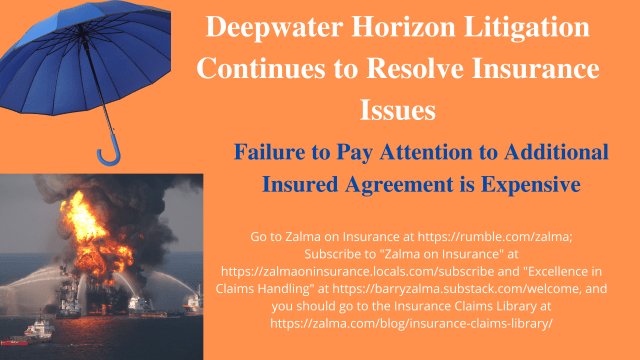Deepwater Horizon Litigation Continues to Resolve Insurance Issues
Failure to Pay Attention to Additional Insured Agreement is Expensive
 In the latest installment of litigation spilling out of the Deepwater Horizon offshore explosion and fire centers on who should pay for personal injury claims brought by employees of two companies hired by BP Exploration & Production Inc. and BP America Production Company (“BP”) to clean up the oil spill. Specifically, BP claims to be an “additional insured” under two policies obtained by O’Brien’s Response Management, L.L.C. (“O’Brien’s”). BP also seeks indemnification by O’Brien’s and/or National Response Corporation (“NRC,” together “Responders”) under its contract with each plaintiff.
In the latest installment of litigation spilling out of the Deepwater Horizon offshore explosion and fire centers on who should pay for personal injury claims brought by employees of two companies hired by BP Exploration & Production Inc. and BP America Production Company (“BP”) to clean up the oil spill. Specifically, BP claims to be an “additional insured” under two policies obtained by O’Brien’s Response Management, L.L.C. (“O’Brien’s”). BP also seeks indemnification by O’Brien’s and/or National Response Corporation (“NRC,” together “Responders”) under its contract with each plaintiff.
In O’Brien’s Response Management, L.L.C.; National Response Corporation v. BP Exploration & Production, Incorporated; BP America Production Company v. Navigators Insurance Company, Third Party, No. 20-30364, United States Court of Appeals, Fifth Circuit (January 19, 2022) the Fifth Circuit resolved the dispute.
BACKGROUND
BP retained the Responders for nearly $2 billion to assist with cleanup efforts in the aftermath of the April 2010 Deepwater Horizon oil spill. BP and O’Brien’s executed a Bridge Agreement in 2010 that incorporated, with modifications, a Master Consulting Services Contract they originally entered into in 2004 (the “BP-O’Brien’s Contract”).
The Responders and their respective subcontractors employed thousands of workers as part of their clean-up efforts. Thousands among these workers then filed personal injury lawsuits against BP, which were consolidated with the multidistrict litigation (“MDL”) arising from the disaster. The district court organized the MDL cases into various “pleading bundles.”
Relevant here, the B3 bundle included “all claims for personal injury and/or medical monitoring for exposure or other injury occurring after the explosion and fire of April 20, 2010.” Although BP emphasizes that the Responders were aware of the settlement before the district court approved it in January 2013, BP does not dispute that neither O’Brien’s nor NRC had control over the negotiations, nor did either approve the settlement.
O’Brien’s is a named insured on two pertinent policies: (1) a Primary Bumbershoot (umbrella) Liability policy issued by Navigators Insurance Company (the “Primary Bumbershoot” policy) providing marine umbrella insurance with an aggregate limit of $10, 000, 000; and (2) an Excess Bumbershoot Liability policy (the “First Excess Bumbershoot” policy) issued by Navigators and other insurers, which incorporates the Primary Bumbershoot’s policy terms and provides excess coverage up to $90,000,000.
The district court ruled against BP on each issue, concluding that (1) BP was not an additional insured under the relevant insurance policies; (2) O’Brien’s was not required to indemnify BP because BP violated the consent-to-settle, notice, and control-of-defense provisions of the BP-O’Brien’s Contract; and (3) NRC was not required to indemnify BP under their contract because NRC “had no liability under ‘Responder Immunity Law.’” The district court also determined that O’Brien’s did not breach its contractual obligation to acquire insurance coverage for BP. BP timely appealed.
DISCUSSION
BP seeks coverage as an “additional insured” under the Primary and Excess Bumbershoot policies covering O’Brien’s. The Texas Supreme Court holds that “insurance policies can incorporate limitations on coverages encompassed in extrinsic documents by reference to those documents.” In re Deepwater Horizon, 470 S.W.3d 452, 460 (Tex. 2015) (citations omitted).
Navigators challenged BP’s claim to be an additional insured on the bumbershoot policies for two primary reasons. Navigators argued that if BP was entitled to additional assured coverage under its bumbershoot policies, then that coverage is limited to the $2,000,000 minimum.
CGL Coverage
To begin, Navigators concedes that the Starr policy provides “standard primary CGL [i]nsurance, modified slightly to cover marine operations.” It also agrees that BP is an additional assured under the Starr and COPS policies, and that its Primary Bumbershoot policy provides excess coverage that “expressly includes the Starr Policy and the COPS policy by name.” Finally, Navigators describes the First Excess Bumbershoot policy as “follow-form” of its primary policy. To state these facts is to conclude that the bumbershoot policies afford CGL-type coverage as described in the BP-O’Brien’s Contract.
Contractual Minimum Coverage
The next question is how much coverage BP is entitled to as an additional assured on the bumbershoot policies. BP contends it is entitled to the full $100,000,000 under these policies notwithstanding that Section 12.01.03 required O’Brien’s to purchase CGL with “minimum limits” of $2 million per occurrence.
The BP-O’Brien’s Contract contraindicates extending BP’s additional assured status to the maximum coverage voluntarily purchased by O’Brien’s. The BP-O’Brien’s Contract specifies CGL coverage with $2 million “minimum limits.”
BP-O’Brien’s Contract, read in full, adopts the $2 million minimum CGL coverage as the maximum required to be furnished by each party for the benefit of the other and that Navigators’ bumbershoot policies incorporated the limit of the contractual obligation.
The Starr and COPS Policies Do Not Satisfy the Minimum
Although the district court correctly concluded that BP was only an additional insured with respect to the $2,000,000 obligated by the BP-O’Brien’s Contract, it erred in concluding that amount was fully satisfied by the Starr and COPS policies (each bearing $1,000,000 coverage limits per occurrence). BP is entitled to $2 million of coverage.
Together, they only constitute $1,000,000 of the $2,000,000 required by the BP-O’Brien’s Contract because they are mutually reinforcing policies designed to satisfy the same obligation by filling in each other’s gaps.
Indemnification Obligations
The district court correctly concluded that BP materially breached the BP-O’Brien’s Contract regarding the Back-End Litigation Option (“BELO”) claims. Those are the claims that BP agreed with the PSC to litigate, if plaintiffs followed certain procedures for claims that arose following the Medical Settlement.
A fundamental principle of contract law is that when one party to a contract commits a material breach of that contract, the other party is discharged or excused from any obligation to perform. By contrast, when a party commits a nonmaterial breach, the other party is not excused from future performance but may sue for the damages caused by the breach.
By entering the Medical Settlement without O’Brien’s consent, BP breached the control-of-defense and consent-to-settle provisions of the indemnity clause. The consent-to-settle provision states that “neither party shall effect settlement or compromise of any claim or proceeding” without obtaining written consent of the other party. BP failed to include O’Brien’s in the negotiation over BELO claims, and it preemptively agreed to deprive the defense of such later-accruing claims of certain defenses while also extending the limitations period to four years.
Finally, the breach was material because the Medical Settlement undisputedly compromised the defense of BELO claims. Because BP’s breach was material, O’Brien’s is not required to indemnify the BELO claims.
CONCLUSION
For the foregoing reasons, the appellate court affirmed the judgment as follows:
BP is an additional insured under the relevant policies only to the extent required to meet the BP-O’Brien’s Contract’s $2, 000, 000 CGL insurance requirement; and
BP materially breached the indemnity provisions under the BP-O’Brien’s Contract with respect to BELO claims, excusing O’Brien’s from performing its indemnification obligations under the contract for those claims.
However, the appellate court reversed the trial court judgment as follows:
The Starr and COPS policies cannot be combined to satisfy the BP-O’Brien’s Contract’s $2, 000, 000 CGL insurance requirement; together they constitute $1, 000, 000 in CGL-type coverage;
Determining whether BP materially breached its obligations under the BP-O’Brien’s Contract with respect to opt-out B3 claims requires factual development on a claim-by-claim basis;
Similarly, the district court must evaluate NRC’s indemnification obligations for opt-out B3 and BELO claims under the BP-NRC Agreement on a claim-by-claim basis.
Ultimately, BP was an additional insured up to the minimum amount required by its contract with O’Brien’s; the two insurance policies maintained by O’Brien’s cannot be combined to satisfy the minimum amount; O’Brien’s is not required to indemnify BP because BP materially breached its indemnification provision with respect to the Back-End Litigation Option (“BELO”) claims brought by O’Brien’s employees; and a claim-by-claim analysis is required to determine the materiality of any breach regarding the remaining indemnity claims against both O’Brien’s and NRC.
ZALMA OPINION
When a party enters into a major contract requiring a vendor to add the other party as an additional insured it is important to carefully write the insurance provisions of the contract. BP made the mistake of setting a minimum amount of insurance that, as a matter of law, became the maximum when it could have simply said that the vendor name BP as an additional insured on all insurance coverage available. By failing to do so the bumbershoot policies were able to avoid putting $100 million in coverage at risk to BP.

© 2022 – Barry Zalma
Barry Zalma, Esq., CFE, now limits his practice to service as an insurance consultant specializing in insurance coverage, insurance claims handling, insurance bad faith and insurance fraud almost equally for insurers and policyholders.
He practiced law in California for more than 44 years as an insurance coverage and claims handling lawyer and more than 54 years in the insurance business.
Subscribe to “Zalma on Insurance” at https://zalmaoninsurance.locals.com/subscribe and “Excellence in Claims Handling” at https://barryzalma.substack.com/welcome.
You can contact Mr. Zalma at https://www.zalma.com, https://www.claimschool.com, zalma@claimschool.com and zalma@zalma.com . Mr. Zalma is the first recipient of the first annual Claims Magazine/ACE Legend Award.
You may find interesting the podcast “Zalma On Insurance” at https://anchor.fm/barry-zalma; you can follow Mr. Zalma on Twitter at; you should see Barry Zalma’s videos on YouTube- https://www.youtube.com/channel/UCysiZklEtxZsSF9DfC0Expg; or videos on https://rumble.com/zalma. Go to the Insurance Claims Library – https://zalma.com/blog/insurance-claims–library/ The last two issues of ZIFL are available at https://zalma.com/zalmas-insurance-fraud-letter-2/







